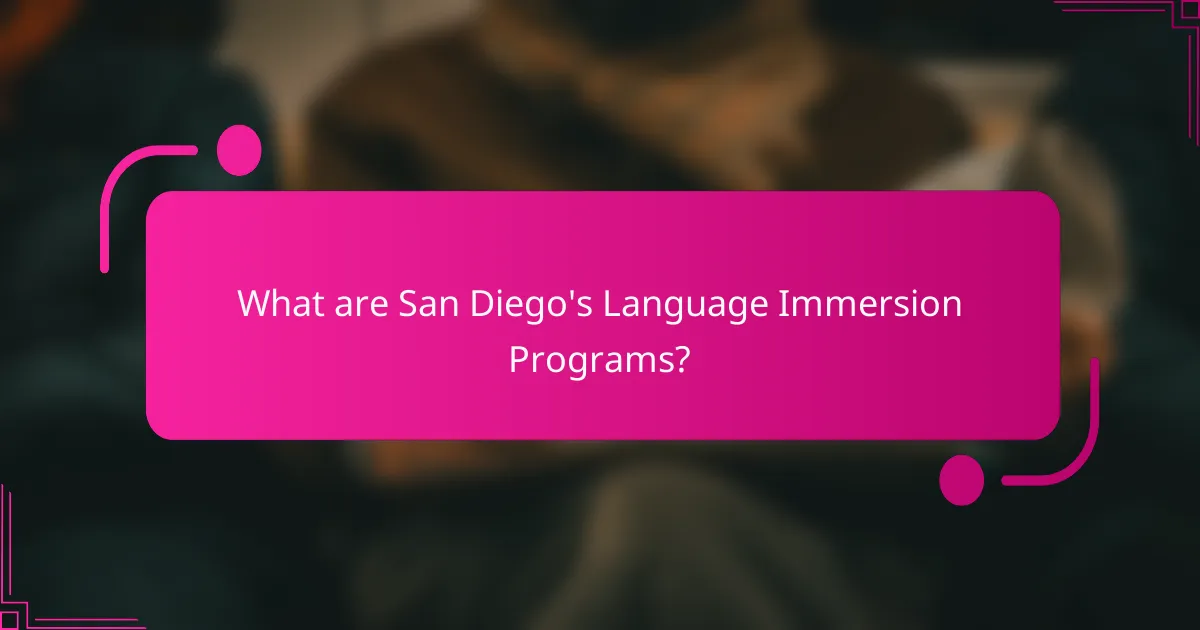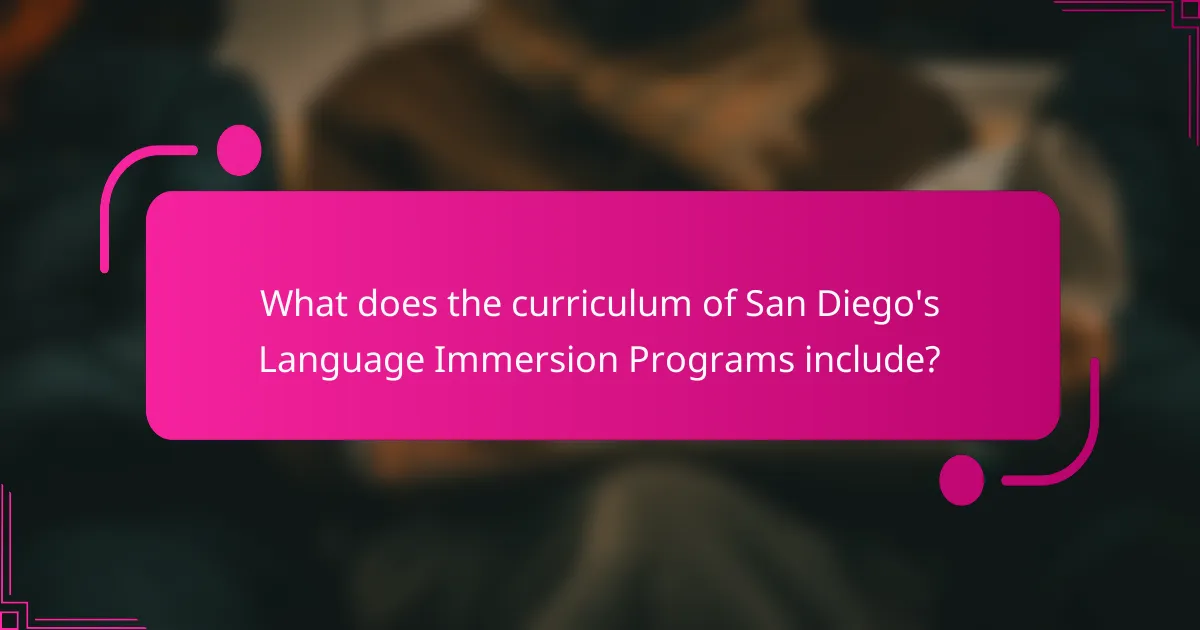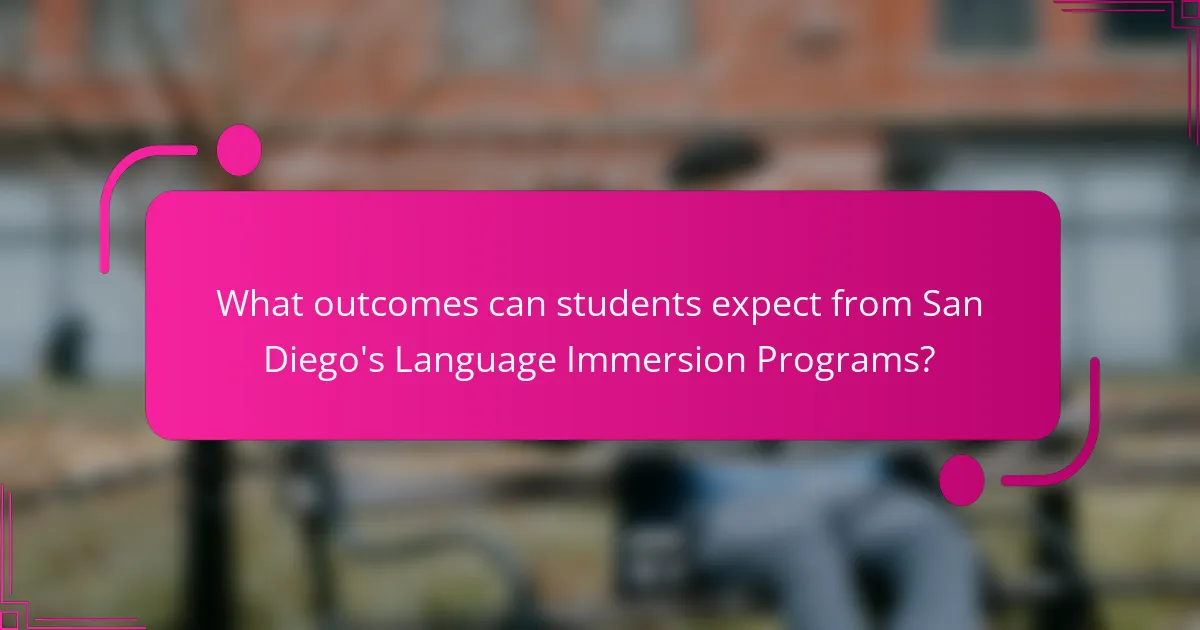
What are San Diego’s Language Immersion Programs?
San Diego’s Language Immersion Programs are educational initiatives that teach students in a second language. These programs aim to promote bilingualism and biliteracy. They typically incorporate subjects like math, science, and social studies into the curriculum, all taught in the target language. Research shows that students in immersion programs often outperform their peers in standardized tests. According to the San Diego Unified School District, these programs enhance cognitive skills and cultural awareness. Immersion programs are available for various languages, including Spanish, Mandarin, and French. They serve students from preschool through high school. The goal is to create fluent speakers who are culturally competent.
How do language immersion programs function in San Diego?
Language immersion programs in San Diego function by integrating foreign language instruction with standard academic subjects. Students learn in a bilingual environment, where a significant portion of the curriculum is delivered in the target language. This method enhances language acquisition through context and practical use.
Typically, students begin these programs in preschool or kindergarten. They continue through elementary and sometimes into secondary education. Teachers in these programs are often fluent in both languages, providing a rich linguistic environment.
Research indicates that immersion students often outperform their peers in both language proficiency and academic achievement. For instance, a study by the Center for Applied Linguistics found that immersion students demonstrate higher scores on standardized tests. This approach fosters not only language skills but also cultural awareness and cognitive flexibility.
What age groups are targeted by these programs?
San Diego’s language immersion programs target various age groups, primarily children aged 3 to 12 years. These programs often begin in preschool and continue through elementary school. Research indicates that early exposure to language enhances cognitive development. The age range aims to capitalize on children’s natural ability to learn languages. Programs may also include middle school students, depending on the specific curriculum offered. This age focus aligns with educational strategies promoting bilingualism from a young age.
What languages are offered in San Diego’s immersion programs?
San Diego’s immersion programs offer several languages. These include Spanish, Mandarin, French, and German. Each program is designed to enhance bilingual proficiency. Students engage in immersive learning experiences. The programs aim to develop language skills through various subjects. Research shows that immersion enhances cognitive abilities. This approach supports cultural understanding and global awareness.
What are the key benefits of participating in these programs?
Participating in San Diego’s language immersion programs offers key benefits such as enhanced language proficiency and cultural awareness. Students experience accelerated language acquisition through immersive environments. Research shows that immersion programs improve cognitive skills and academic performance. For instance, a study by Thomas and Collier (2002) found that students in immersion programs outperform peers in standardized tests. Additionally, these programs foster social skills and adaptability in diverse settings. Participants often develop a deeper appreciation for different cultures. Overall, immersion programs provide valuable skills for global citizenship and future career opportunities.
How do language immersion programs enhance cognitive development?
Language immersion programs enhance cognitive development by promoting bilingualism and cognitive flexibility. These programs immerse students in a second language, facilitating deeper language acquisition. Research indicates that bilingual individuals often demonstrate improved problem-solving skills. They also show enhanced creativity due to their ability to think in multiple languages. Studies reveal that students in immersion programs perform better on standardized tests. They typically excel in tasks requiring executive function. Cognitive benefits include improved memory retention and attention control. Overall, immersion programs foster critical thinking and adaptability in learners.
What social benefits do students gain from language immersion?
Students gain enhanced social skills from language immersion. They develop better communication abilities through interaction with peers. Language immersion fosters cultural awareness and appreciation. It encourages collaboration among students from diverse backgrounds. Research indicates that bilingual students often have improved empathy and adaptability. These social benefits contribute to a more inclusive classroom environment. Language immersion programs promote teamwork and problem-solving skills. Students also build lasting friendships across cultural lines.

What does the curriculum of San Diego’s Language Immersion Programs include?
The curriculum of San Diego’s Language Immersion Programs includes language instruction, cultural studies, and academic content. Students engage in learning core subjects like math, science, and social studies in the target language. This approach promotes bilingualism and biliteracy. The programs also emphasize cultural awareness and appreciation. Instruction is typically delivered by teachers fluent in both the target language and English. Students participate in hands-on activities and collaborative projects. Assessments are conducted in both languages to measure proficiency. Research indicates that such programs enhance cognitive skills and academic performance.
How is the curriculum structured in these programs?
The curriculum in San Diego’s language immersion programs is structured to integrate language learning with core academic subjects. This approach allows students to develop language skills while engaging with content in subjects like math, science, and social studies. The programs typically follow a 50/50 model, where half of the instruction is delivered in the target language and the other half in English. This balance supports bilingualism and biliteracy development. Additionally, the curriculum is designed to be culturally relevant, incorporating themes and materials that reflect the diverse backgrounds of the students. Research indicates that such immersive environments enhance language acquisition and cognitive skills.
What teaching methods are employed in the curriculum?
The curriculum employs a variety of teaching methods. These include immersion techniques, where students learn a second language through content-based instruction. Collaborative learning is also utilized, promoting interaction among students. Project-based learning encourages students to engage in real-world tasks. Differentiated instruction caters to diverse learning needs within the classroom. Additionally, experiential learning provides hands-on experiences related to language use. Research shows that these methods enhance language acquisition and cultural understanding. Studies indicate that immersion programs lead to higher proficiency levels in both the target language and English.
How does the curriculum integrate cultural education?
The curriculum integrates cultural education by incorporating diverse cultural perspectives into language instruction. It includes lessons on history, traditions, and values of various cultures. This approach fosters understanding and appreciation among students. Activities often involve cultural celebrations and projects. Students engage with authentic materials from different cultures. Teachers receive training to effectively deliver cultural content. Research indicates that cultural education enhances language acquisition and social skills. Programs aim to create a culturally responsive learning environment.
What resources are available to support the curriculum?
Curriculum resources for San Diego’s Language Immersion Programs include textbooks, digital materials, and professional development workshops. Textbooks provide structured content aligned with language learning goals. Digital materials enhance interactive learning experiences through multimedia resources. Professional development workshops equip educators with effective teaching strategies. These resources support diverse learning styles and promote language proficiency. Research indicates that well-resourced language programs lead to improved student outcomes. For example, a study by the Center for Applied Linguistics shows that comprehensive resources significantly enhance language acquisition in immersion settings.
What role do teachers play in delivering the curriculum?
Teachers play a crucial role in delivering the curriculum. They facilitate the learning process by implementing instructional strategies tailored to students’ needs. Teachers design lesson plans that align with curriculum standards. They assess student understanding through various evaluation methods. Teachers provide feedback that guides student improvement. They create a supportive classroom environment that encourages engagement. Research shows that effective teaching directly impacts student outcomes. A study by Hattie (2009) indicates that teacher effectiveness is one of the most significant factors influencing student achievement.
How are parents involved in the educational process?
Parents are involved in the educational process through various activities and support mechanisms. They participate in school events, such as parent-teacher conferences and open houses. Parents also help with homework and reinforce learning at home. They communicate regularly with teachers to discuss their child’s progress. Additionally, parents may volunteer in classrooms or assist in extracurricular activities. Research indicates that parental involvement positively impacts student achievement and motivation. A study by the National Education Association found that students with engaged parents are more likely to earn higher grades and enjoy school.

What outcomes can students expect from San Diego’s Language Immersion Programs?
Students in San Diego’s Language Immersion Programs can expect enhanced language proficiency. These programs promote bilingualism, allowing students to become fluent in both English and the target language. Cognitive benefits include improved problem-solving skills and increased creativity. Research shows that immersion students often outperform their peers in standardized tests. Additionally, cultural awareness and appreciation develop through exposure to diverse languages and traditions. Social skills are enhanced as students collaborate with peers from various backgrounds. Long-term academic success is also a common outcome, with many immersion students pursuing advanced studies. Overall, these programs prepare students for a globalized world.
How do language immersion programs impact academic performance?
Language immersion programs positively impact academic performance. Students in these programs often show higher proficiency in both the immersion language and their native language. Research indicates that immersion students outperform their peers in standardized tests. For instance, a study by Genesee (2004) found that immersion students excelled in reading and math compared to non-immersion students. Additionally, these programs enhance cognitive skills such as problem-solving and critical thinking. Language immersion fosters a deeper cultural understanding, which can enrich the overall educational experience. Overall, the structure of immersion programs supports improved academic outcomes across various subjects.
What evidence supports the effectiveness of these programs?
Research indicates that San Diego’s language immersion programs significantly enhance student language proficiency. A study by Thomas and Collier (2002) found that students in immersion programs outperform their peers in traditional settings in both language skills and academic achievement. Additionally, data from the California Department of Education shows that immersion students consistently score higher on standardized tests. Observations also reveal increased cultural awareness among students, contributing to better social integration. Furthermore, longitudinal studies indicate that immersion graduates maintain language skills well into adulthood. These findings collectively support the effectiveness of San Diego’s language immersion programs.
How do students perform in standardized tests compared to peers?
Students in San Diego’s language immersion programs typically perform better in standardized tests compared to their peers in traditional programs. Research conducted by the Center for Applied Linguistics shows that immersion students often score higher in reading and math assessments. A study published in the Journal of Educational Psychology found that bilingual students demonstrate enhanced cognitive skills, contributing to improved test performance. Additionally, standardized test results from California’s Department of Education indicate that immersion programs lead to higher proficiency levels in both language and academic subjects. These findings suggest that the immersive approach positively influences student outcomes in standardized testing.
What long-term benefits do graduates experience?
Graduates of language immersion programs experience enhanced cognitive abilities and improved language proficiency. These programs contribute to better problem-solving skills and greater cultural awareness. Research indicates that bilingual individuals often outperform monolingual peers in various cognitive tasks. Additionally, graduates tend to have increased job opportunities and higher earning potential in a globalized job market. Studies show that bilingualism can lead to a 10-20% salary increase compared to monolingual individuals. Furthermore, graduates often display greater adaptability and resilience in diverse environments. These long-term benefits position graduates for success in both personal and professional realms.
How does bilingualism influence career opportunities?
Bilingualism positively influences career opportunities by enhancing employability and marketability. Employers increasingly seek candidates with language skills, especially in globalized industries. According to a study by the Economist Intelligence Unit, 70% of employers value bilingualism in their hiring processes. Bilingual individuals often have access to a wider range of job positions. They can work in diverse fields such as education, healthcare, and international business. Additionally, bilingual employees typically earn higher salaries than their monolingual counterparts. Research from the American Council on the Teaching of Foreign Languages shows that bilingual individuals can command a salary premium of up to 20%. Thus, bilingualism significantly broadens career prospects and improves financial outcomes.
What are the personal growth outcomes for students?
Personal growth outcomes for students include increased self-confidence, improved communication skills, and enhanced cultural awareness. Language immersion programs foster these outcomes by engaging students in real-life language use. Students often develop greater adaptability and problem-solving skills through immersive experiences. Research indicates that bilingual students exhibit higher cognitive flexibility. Additionally, these programs encourage collaboration and teamwork among peers. Students also gain a deeper appreciation for diversity and global perspectives. Overall, language immersion significantly contributes to holistic personal development in students.
What tips can help parents choose the right language immersion program?
Parents should consider several factors when choosing a language immersion program. First, examine the program’s curriculum and teaching methods. Effective programs use a communicative approach that emphasizes interaction. Next, assess the qualifications of the instructors. Experienced teachers with native proficiency enhance language acquisition. Additionally, review the program’s immersion level. Full immersion typically provides better language outcomes than partial immersion. Consider the school’s reputation and parent reviews. Research shows that positive feedback correlates with successful language learning experiences. Lastly, verify the program’s alignment with educational standards. Programs adhering to recognized standards often yield better student performance.
San Diego’s Language Immersion Programs are educational initiatives designed to teach students in a second language, promoting bilingualism and biliteracy through an integrated curriculum that includes core subjects like math and science. These programs, available for various languages such as Spanish, Mandarin, and French, target children primarily aged 3 to 12 and have been shown to enhance cognitive skills, cultural awareness, and academic performance. Key benefits include improved language proficiency, social skills, and long-term career opportunities, supported by research indicating that immersion students often outperform their peers in standardized tests. The curriculum emphasizes cultural education and employs diverse teaching methods to foster an immersive learning environment.